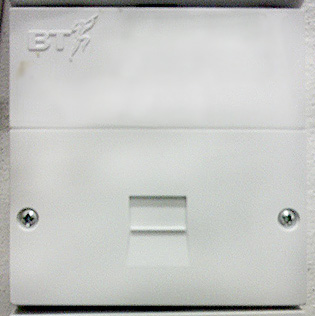BT iPlate (also named Broadband Accelerator)
Around £6 plus postage, available from BT and broadbandbuyer.co.uk
If, like me, you have an ADSL internet connection with your service provider, you're always looking at ways to try and improve speed but also more importantly have a stable connection. I live a considerable distance from my local exchange, so as you can imagine, speeds aren't exactly the quickest. Until Sky unceremoniously capped my broadband speed without warning, I got around 2.5Mbits speed, and now under O2 Broadband, I'm getting around 2.6Mbits, which is better than I thought it might be.
Of course, any speed increased may well come in handy, so I decided to take the plunge by purchasing a BT iPlate. It's also been recently named as the BT Broadband Accelerator, but you should be able to find one online if you search for either phrase. I purchased mine from the excellent broadbandbuyer.co.uk site, and before I commence with the main review, just a thumbs up to them. I ordered the product late Monday evening, I had an email from them Tuesday morning to say that the product was despatched and I had it first class post on the Wednesday morning. How good was that? It makes you wonder why all online stores can't be as good, so much kudos to them.
Firstly, something to check before you buy the iPlate. Your BT Master socket needs to be of a certain type, which has a split top and bottom section with the bottom part unscrewable. If it's not, then you won't really be getting any benefit from this because the stuff the iPlate does may have been taken care of in your master socket. If it has Openreach on it, or a bit sticking out of the front with an ADSL filter, then no need to bother really. Your socket needs to look like the one below, with the BT logo on the top left or top right.

So, if it looks like that, and you have any form of extension wiring coming in some way from the master socket itself, then the chances are you may well benefit from the speed increase offered.
So what does the iPlate actually do? Well, in pure and simple terms, it filters out the bell wire signal from your home phone line. In the old days of analogue telephony, this bell wire carried the ringing signal for the analogue phone so you could hear it ring out (think of the brrrring brrrrring noises you used to hear when you were younger). Of course most modern telephones, especially any touch tone or DECT cordless ones, don't need any of that bell wire stuff going on, so in effect you don't need it. One word of note though: although you could of course chop off the bell wire yourself in the master socket, doing that might be technically damaging what's essentially BT property behind the face plate - so be warned.
Fitting the iPlate was really simple. You unscrew the two screws from the master socket itself and remove this front plate section. Behind that should be a phone socket to plug the iPlate in, which fits snugly on. You then put the front plate section on top of the iPlate, effectively plugging the BT socket part into the iPlate. The iPlate also has a small cutout at the bottom so any extension wiring you've got that goes into the socket can be fed through. You also get two replacement screws with the iPlate, this is of course so you can screw the master socket back together. The screws are longer because of course now you have an iPlate in place as well. When finished, you'll see it will sit a bit further forward out of the wall than it did before, so make sure you've got enough room!
Now, once you've fitted the iPlate, it can take a few days for the BT circuitry to recognise that you've got an iPlate in play, and then it can resynch its broadband profile for your home phone line as you've effectively filtered out the unnecessary bell wire. With that in mind I did five broadband connection tests by powering off and on my router at different periods of the day and found that I averaged around 2.6Mbits across the five tests, which was a good benchmark to test against.
I then did five separate connections, again by powering off the router and then on again and allowing the broadband connection to synchronise properly each time, and then access the router and see what stats that I got. Well, the results weren't necessarily the improvement claimed by BT, but I did see a speed increase. What was an average of 2.6MBits is now an average of 3.0Mbits, and in real terms that's a 15% increase in speed. What I also noticed was that the broadband connection seemed much more rugged in terms of dropout - in fact unless I restarted the router itself I didn't a single of instance of any signal dropout and router restart, which I occasionally got before.
Of course, mileage is going to vary between users depending on a number of factors such as exchange distance, what other phone socketry you have in the house, and of course what interference your existing phone bell wire might be getting, but if my experience is anything to go by, and if you have broadband through a BT phone line, then something like the iPlate might just help you eke out the speeds that you want to achieve, and also in the bargain doesn't look too obtrusive when fitted either. Provided you have the necessary socket, it might prove an inexpensive boost!
Warren's rating: 83%